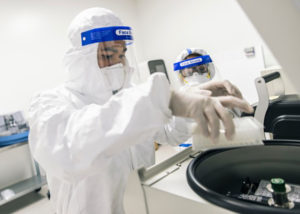
Amazon Diagnostics’ COVID-19 testing lab in Hebron, Kentucky[Image courtesy of Amazon]
Amazon’s anti-friction focus will find many opportunities in healthcare.
Here we go again.
That was my first thought when reading the news that Seattle-based Amazon (Nasdaq:AMZN) plans to buy One Medical for nearly $4 billion.
The deal immediately brought to mind Amazon’s $13.7 billion acquisition of Whole Foods, which to this day remains Amazon’s largest purchase. The retail business is a different industry than healthcare, but there are plenty of similarities that the medical device and pharmaceutical industries ought to consider.
For one, Amazon’s retail efforts have always focused on customer convenience, from the early days of online book buying to the patented one-click “buy now” button and fee-generating Prime memberships, which topped 200 million subscribers last year. (One Medical reported about 767,000 members for its business as of the end of March.)
Another example is Amazon’s cashierless grab-and-go shops and stores. Five years after buying Whole Foods, Amazon has transferred its “Just Walk Out” technology from small Amazon Go convenience stories to select Whole Foods stores.
“We observed areas that caused friction for customers, and we diligently worked backward to figure out ways to alleviate that friction,” Amazon Physical Retail and Technology VP Dilip Kumar told the New York Times when opening the first Whole Foods with Just Walk Out technology earlier this year. “We’ve always noticed that customers didn’t like standing in checkout lines. It’s not the most productive use of their time, which is how we came up with the idea to build Just Walk Out.”
What’s that got to do with healthcare? If you hate all the headaches of the American healthcare system, your blood pressure might spike as you read Amazon Health Services SVP Neil Lindsay discussing the One Medical deal.
“Booking an appointment, waiting weeks or even months to be seen, taking time off work, driving to a clinic, finding a parking spot, waiting in the waiting room then the exam room for what is too often a rushed few minutes with a doctor, then making another trip to a pharmacy,” Lindsay said in a news release, painting a painfully accurate picture before offering Amazon’s solution: “We see lots of opportunity to both improve the quality of the experience and give people back valuable time in their days.”
Amazon has a history of turning internal tools into business opportunities. Amazon’s cloud business started as a way to scale its own digital infrastructure. Today, cloud computing is Amazon’s biggest business, with the market-leading Amazon Web Services reporting $62.2 billion in 2021 revenue — and $18.5 billion in operating income.
RELATED: Amazon Web Services is powering medtech innovation, its chief medical officer explains
And though it hasn’t yet taken off in the same way, Amazon has started licensing its Just Walk Out technology to retailers like Hudson Nonstop and Fred Segal Market, plus arenas like Boston’s TD Garden and the Seattle Kraken’s NHL rink (the naming rights for which Amazon reportedly paid hundreds of millions of dollars.)
Don’t expect any big changes fast. Amazon is also known for taking the long-term approach when building new tools and businesses, even at the expense of profitability.
Here are a few more things medical device makers should consider: Amazon’s also known for cut-throat competition even with its own partners, leveraging its market position and purchasing power to negotiate lower costs from suppliers, and making data-driven decisions across the organization by measuring a mind-boggling menagerie of metrics — but keeping gut-level instincts in play.
Amazon’s previous healthcare efforts have failed to replicate the success of AWS, with some flaming out after similarly lofty goals, Executive Editor Chris Newmarker noted in his report on Amazon’s One Medical deal.
But Amazon’s now identified a new way to get a slice of the healthcare market — and it’s a big pie, at around 20% of U.S. GDP — at a time when the retail giant’s brick-and-mortar tools are tuned and its cloud computing abilities have never been more vast.
Can Amazon navigate the regulatory burdens and find ways to innovate a change-resistant industry while appreciating the life-and-death stakes for patients?
Here we go again.